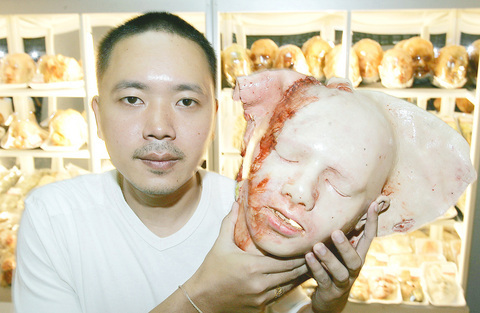Inside a dark room, realistic-looking "human body parts" are stacked on shelves and hanging on meat hooks. The place looks like a mortuary or the lair of a serial killer, but in fact, it's a bakery.
What appears to be putrefying body parts are the bread sculptures of 28-year-old art student Kittiwat Unarrom.
"Of course, people were shocked and thought that I was mad when they saw the works. But once they knew the idea behind it, they understood and became interested in the work itself, instead of thinking that I am crazy," said the fine arts masters-degree student.

PHOTO: AP
He hopes his realistic artwork will make people ponder whether they are consuming food, or food is consuming them.
"Everyone's life is rushed nowadays, even when it comes to eating," he said. "When we eat, we don't think about our health or safety, we only think of our taste buds."
As an undergraduate, Kittiwat started painting portraits. He then moved to mixed media and finally dough -- a natural medium for him since his family runs a bakery.

PHOTO: AP
Along with edible human heads crafted from dough, chocolate, raisins and cashews, Kittiwat makes human arms, feet, and chicken and pig parts. He uses anatomy books and memories of visiting a forensics museum to create the human parts.
He now is receiving regular orders from the curious and from pranksters who want to surprise their friends or colleagues, but that's a minor sideline.
By the end of the year, Kittiwat's confectionary slaughterhouse will go on display at Bangkok's Silpakorn University. It's his final dissertation, and he hopes it will secure him a master of arts degree.
"When people see the bread, they don't want to eat it. But when they taste it, it's just normal bread," he said. "The lesson is `don't judge just by outer appearances."'

SECURITY: As China is ‘reshaping’ Hong Kong’s population, Taiwan must raise the eligibility threshold for applications from Hong Kongers, Chiu Chui-cheng said When Hong Kong and Macau citizens apply for residency in Taiwan, it would be under a new category that includes a “national security observation period,” Mainland Affairs Council (MAC) Minister Chiu Chui-cheng (邱垂正) said yesterday. President William Lai (賴清德) on March 13 announced 17 strategies to counter China’s aggression toward Taiwan, including incorporating national security considerations into the review process for residency applications from Hong Kong and Macau citizens. The situation in Hong Kong is constantly changing, Chiu said to media yesterday on the sidelines of the Taipei Technology Run hosted by the Taipei Neihu Technology Park Development Association. With

CARROT AND STICK: While unrelenting in its military threats, China attracted nearly 40,000 Taiwanese to over 400 business events last year Nearly 40,000 Taiwanese last year joined industry events in China, such as conferences and trade fairs, supported by the Chinese government, a study showed yesterday, as Beijing ramps up a charm offensive toward Taipei alongside military pressure. China has long taken a carrot-and-stick approach to Taiwan, threatening it with the prospect of military action while reaching out to those it believes are amenable to Beijing’s point of view. Taiwanese security officials are wary of what they see as Beijing’s influence campaigns to sway public opinion after Taipei and Beijing gradually resumed travel links halted by the COVID-19 pandemic, but the scale of

A US Marine Corps regiment equipped with Naval Strike Missiles (NSM) is set to participate in the upcoming Balikatan 25 exercise in the Luzon Strait, marking the system’s first-ever deployment in the Philippines. US and Philippine officials have separately confirmed that the Navy Marine Expeditionary Ship Interdiction System (NMESIS) — the mobile launch platform for the Naval Strike Missile — would take part in the joint exercise. The missiles are being deployed to “a strategic first island chain chokepoint” in the waters between Taiwan proper and the Philippines, US-based Naval News reported. “The Luzon Strait and Bashi Channel represent a critical access

Pope Francis is be laid to rest on Saturday after lying in state for three days in St Peter’s Basilica, where the faithful are expected to flock to pay their respects to history’s first Latin American pontiff. The cardinals met yesterday in the Vatican’s synod hall to chart the next steps before a conclave begins to choose Francis’ successor, as condolences poured in from around the world. According to current norms, the conclave must begin between May 5 and 10. The cardinals set the funeral for Saturday at 10am in St Peter’s Square, to be celebrated by the dean of the College